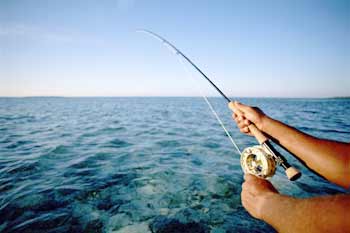How Ocean Fly Fishing Works
Fly fishing is somewhat of an art. Anglers who enjoy this activity know it takes plenty of skill and patience. Some common fish anglers look for are sea bass, sea trout, tuna, and bluefish. Many anglers are afraid to try sea fly fishing, thinking it is too difficult and requires expensive equipment. But, that is not usually the case. By considering a few basic tips about selecting equipment and learning a few basic skills, any angler can have fun with fly fishing at sea.
 The first tip is to find a comfortable pole. It doesn't need to be top of the line. It mere needs to be sturdy and easy to handle. Versatility may be another feature to look for. A 9 weight rod is suitable for most sea fishing attempts, unless going after prize winning sized fish. But, most beginners aren't going after the big prize. A heavier weight is helpful only for those larger fish.
The first tip is to find a comfortable pole. It doesn't need to be top of the line. It mere needs to be sturdy and easy to handle. Versatility may be another feature to look for. A 9 weight rod is suitable for most sea fishing attempts, unless going after prize winning sized fish. But, most beginners aren't going after the big prize. A heavier weight is helpful only for those larger fish.
Stiffness of the pole makes it easier to handle. Fly anglers must allow the line to sink and use a quick, almost jerking action to simulate the movements of the bait. The line and reel should match the pole. A heavy line is more suited to a 10 or 11 weight pole. However, the line should be heavy enough to sink quickly. A 15-20 pound test line should work well with the 9 weight pole. One of the goals of using a fly, is to get the bait at the bottom and attracting the right fish quickly. Otherwise, the fish may become disinterested. A lighter test line will not accomplish this goal. A heavier line will create arm, shoulder, and hand fatigue more quickly.
When buying fly gear, local shops almost always carry suitable poles and reels, which are ideal for the specific region or location. Some will discount products they can't seem to sell and these may be the best deals around.
When the right equipment has been found, learning to cast is the next challenge. Those who have used flies on a river will have the basic technique. Others may want to practice in an open field or shallow waters, until the basic technique is learned. For those who are patient and will to spend at least 30 minutes a day, the technique can be learned in as little as a day or two, or over a weekend.
The fly is also important. It must be suited to the type of fish a person is going for. Again, versatility is key. Some minnow type flies can be used in water as shallow as six inches and in depths up to 60 feet. Local shops will usually carry flies designed for local fish as well. The final step is finding out where the fish are, by talking to locals and reading reports.